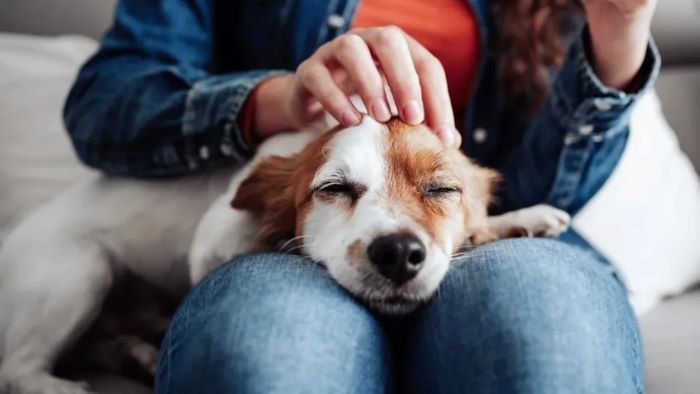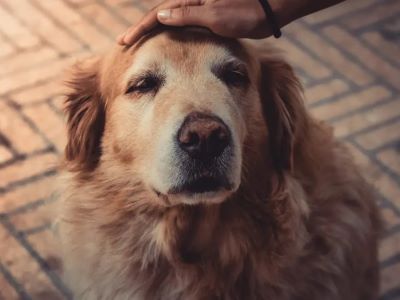For every paw parent petting their fur baby is emotion, which connects them. Paw parents express their love through the pet and dogs too respond to it. But have you ever wondered, “Where do dogs like to be pet?”.
Through our blog, we will provide you with the information regarding the same so that next time you can pet your dog without causing them discomfort.

Why Dogs Like To Be Pet?
Generally, it is observed that dogs love getting pets. It is the way in which humans and dogs communicate with each other. Petting the dog strengthens the bond between human and their canine companion and helps to build a sense of trust and understanding.
When we bring home a dog, we are strangers to them, petting helps them to build physical, emotional and chemical bonds with us. When you pet your dog, it triggers the endorphins and oxytocin hormones[1] to release.
Endorphin is the hormone which helps the dog to reduce the stress level. This is why after petting you can see the sense of relaxation in your dog. On the other hand, oxytocin also popularly called the love hormone helps to establish the affectionate bond.
However, the petting differs in dogs and their petting spot differs. Petting your dog builds a sense of trust and security between you and your dog. This helps you to bond and connect with your dog.
How To Pet a Dog the Right Way?
It is very important to know the right way to pet a dog in order to avoid causing any discomfort to them. Here are the “Do’s and Don’t” you need to follow while petting a dog:

| Do’s | Don’t |
| Seek the owner’s permission before petting the dog. If the dog is your own then look for signs whether your dog is comfortable or not. | While petting a dog don’t approach a dog directly let the dog initiate the approach. |
| Before petting the dog let him be familiar with you. Let the dog sniff you. | Avoid petting dogs on their head, faces and paws. This is a sensitive area for dogs and they may not like petting them. |
| Pet the dog gently and calmly. | Don’t pet the dog aggressively, this may scare the dog and he may act defensively. |
| Identify the dog’s favourite petting spot and then pet accordingly. | Avoid petting dogs in their sensitive areas. |
| Pay attention to how a dog reacts to the petting. If a dog shows a happy sign like tail wagging then continue doing it, but if your dog is moving away from you then stop as he does not like it. | Don’t pet aggressive dogs, as they may in return attack you leading to injuring you. |
Where Do Dogs Like To Be Pet?
Here are the spots where dogs like to be pet:
- Neck: Dogs like to be petted on the neck. The dog’s neck is a spot which is covered with the collar, rubbing it helps them feel good. It also helps to release the tension in their throat muscle.
- Chest: A dog’s chest is the best place to pet them, it is the safest spot as it is not a sensitive area. There is a hollow space in your dog’s chest which has muscles. Petting there helps the muscles receive the massage.
- Ears: The dog’s ears are thin and full of nerves passing through it. Due to this reason, the blood flow is high there. Petting the ears releases the endorphins further relaxing your dog.
- Shoulders: The shoulder of a dog has a lot of muscles, gently pressing and massaging them helps to provide relief from anxiety and stress.
- Rump: The rump is the dog’s lower base of the tail. Petting them there helps to boost the nerves and promotes blood flow.
How To Read Your Dog’s Body Language?
It is very important to understand the dog’s body language to understand their behaviour. Body language can also provide you the ideas regarding the comfort and discomfort of your dog:

Eyes
To understand the dog’s body language look into their eyes. If a dog is happy they eyes tend to be normal-sized. To ask for something they will either constantly stare at you or blink.
If a dog is in discomfort then they will widen their eyes and to stop you from approaching the dog will avoid eye contact. To show aggression the dog will exhibit the whites of the eyes, which is typically known as whale eye.
Tail
A dog’s tail is considered the indicator of their emotions. If a dog is happy then he will wag the tail fast and if the dog is scared or is in discomfort then he will tuck the tail between his legs.
Ears
A dog’s ear is raised either upwards or bent forward to express their happy and curious behaviour. You may have noticed that if you are talking suddenly there will be movement in your dog’s ear to listen. If your dog is fearing something or is anxious he will flatten his ears backside.
Posture
Dog’s posture clearly displays their comfort and discomfort. A happy and ready-to-meet dog will display a relaxed posture and will approach you. On the contrary, the aggressive dog will show a tense posture with a rigid body and fur raised.
Keep in mind that dogs can’t verbalize their feelings. Instead, it’s essential to understand your dog’s cues, such as ear position, gaze, and body positioning. “Any time a dog moves away from you when touching them, it is a great indication they don't want to be touched,” Dr. Samantha Stanley, a veterinarian at GoodVets in Charlotte, North Carolina says through petmd.
How To Respect Your Dog’s Personal Space?
Here are the things to keep in mind while approaching a dog to respect their personal space:
- If the dog is calm and composed then only you should approach him.
- Do not approach a sleeping, or eating dog and avoid disturbing them while they are playing with chew toys.
- If the dog is aggressive then avoid being in contact as it can cause harm to you.
- While approaching a dog avoid direct eye contact and let them sniff you properly.
- While interacting with dogs bend down at their level and before touching them indulge in verbal interaction.
FAQs
Where do dogs like to be pet?
There is no exact answer to this question as different dogs have different have different favourable petting spots. Some of the common places where your dog might like to get a pet are the lower back, belly rubs, top of the head and under the chin.
Is there a right way to pet a dog?
Yes, there is a right way to pet a dog and that should be followed to avoid discomfort for your dog. While petting your dog be calm and gentle and keep observing the dog’s behaviour. If your dog likes petting them he will probably wag his tail and will want you to do it again if you stop.
When not to pet a dog?
If your dog is sleeping, eating or chewing a toy avoid petting him. Apart from this if your dog is aggressive or is in a bad angry mood then avoid petting as he can charge up on you causing injury to you.
Where to pet a dog to relax?
To know the petting spot which relaxes your dog, you need to observe your dog’s behaviour. Normally dogs prefer to be petted on the back, belly, and neck. While petting if your dog relaxes or wants to be petted more frequently that means he likes it.
Where can I pet a stressed dog?
Petting a stressed dog is very complicated as your slightest action can easily irritate them. So if your dog is stressed gently and calmly try petting a dog on the belly. Normally dogs like being petted on the belly and it helps to relax and reduce their stress.
Conclusion
We hope that through our blog, “Where do dogs like to be pet?” we have provided you with good sort of information. Petting dogs have a high emotional value for paw parents and it is necessary to make this emotion reach the dogs without an ounce of issue and discomfort.
We hope that now you know where to pet your dog and how to make them comfortable. Petting your dog right without saying enhances your bond with them.
Reference:
- Wirobski, G., Range, F., Schaebs, F. S., Palme, R., Deschner, T., & Marshall-Pescini, S. (2021). Endocrine changes related to dog domestication: Comparing urinary cortisol and oxytocin in hand-raised, pack-living dogs and wolves. Hormones and Behavior, 128, 104901.



